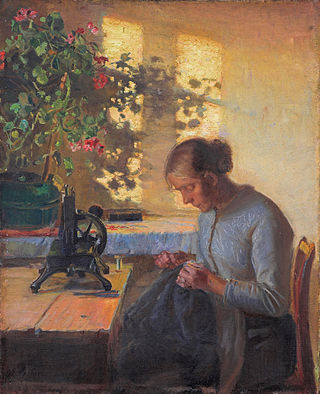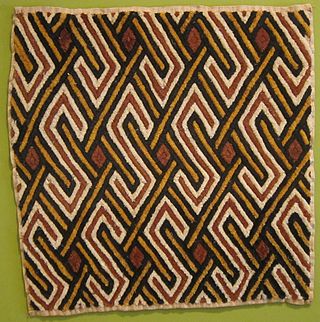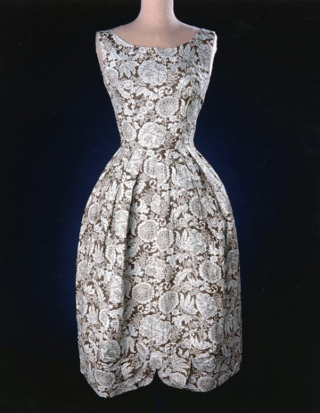
The kimono is a traditional Japanese garment and the national dress of Japan. The kimono is a wrapped-front garment with square sleeves and a rectangular body, and is worn left side wrapped over right, unless the wearer is deceased. The kimono is traditionally worn with a broad sash, called an obi, and is commonly worn with accessories such as zōri sandals and tabi socks.

Quilting is the term given to the process of joining a minimum of three layers of fabric together either through stitching manually using a needle and thread, or mechanically with a sewing machine or specialised longarm quilting system. An array of stitches is passed through all layers of the fabric to create a three-dimensional padded surface. The three layers are typically referred to as the top fabric or quilt top, batting or insulating material, and the backing.

A sewing machine is a machine used to sew fabric and materials together with thread. Sewing machines were invented during the first Industrial Revolution to decrease the amount of manual sewing work performed in clothing companies. Since the invention of the first sewing machine, generally considered to have been the work of Englishman Thomas Saint in 1790, the sewing machine has greatly improved the efficiency and productivity of the clothing industry.

A quilt is a multi-layered textile, traditionally composed of two or more layers of fabric or fiber. Commonly three layers are used with a filler material. These layers traditionally include a woven cloth top, a layer of batting or wadding, and a woven back combined using the techniques of quilting. This is the process of sewing on the face of the fabric, and not just the edges, to combine the three layers together to reinforce the material. Stitching patterns can be a decorative element. A single piece of fabric can be used for the top of a quilt, but in many cases the top is created from smaller fabric pieces joined, or patchwork. The pattern and color of these pieces creates the design.

Sewing is the craft of fastening or attaching objects using stitches made with a sewing needle and thread. Sewing is one of the oldest of the textile arts, arising in the Paleolithic era. Before the invention of spinning yarn or weaving fabric, archaeologists believe Stone Age people across Europe and Asia sewed fur and leather clothing using bone, antler or ivory sewing-needles and "thread" made of various animal body parts including sinew, catgut, and veins.

A hem in sewing is a garment finishing method, where the edge of a piece of cloth is folded and sewn to prevent unravelling of the fabric and to adjust the length of the piece in garments, such as at the end of the sleeve or the bottom of the garment.

Fast fashion is the business model of replicating recent catwalk trends and high-fashion designs, mass-producing them at a low cost, and bringing them to retail quickly while demand is at its highest. The term fast fashion is also used generically to describe the products of this business model. Retailers who employ the fast fashion strategy include Primark, H&M, Shein, and Zara, all of which have become large multinationals by driving high turnover of inexpensive seasonal and trendy clothing that appeals to fashion-conscious consumers.

African textiles are textiles from various locations across the African continent. Across Africa, there are many distinctive styles, techniques, dyeing methods, and decorative and functional purposes. These textiles hold cultural significance and also have significance as historical documents of African design.

Fashion design is the art of applying design, aesthetics, clothing construction and natural beauty to clothing and its accessories. It is influenced by culture and different trends, and has varied over time and place. "A fashion designer creates clothing, including dresses, suits, pants, and skirts, and accessories like shoes and handbags, for consumers. He or she can specialize in clothing, accessory, or jewelry design, or may work in more than one of these areas."

Sustainable fashion is a term describing efforts within the fashion industry to reduce its environmental impacts, protect workers producing garments, and uphold animal welfare. Sustainability in fashion encompasses a wide range of factors, including "cutting CO2 emissions, addressing overproduction, reducing pollution and waste, supporting biodiversity, and ensuring that garment workers are paid a fair wage and have safe working conditions".

Sew Fast Sew Easy was a corporation based in the Garment District in New York City, that is best known for sewing classes, sewing patterns and sewing books. It was founded in 1991 by Elissa K. Meyrich, a designer in New York City's garment district for over 26 years, an instructor at Parsons School of Design, and an author and contributing writer to sewing publications. Sew Fast Sew Easy classes were part of a resurgence in traditional home economics enabled by networked technologies including Internet chat groups and digitally-adjustable patterns.

Electronic textiles or e-textiles are fabrics that enable electronic components such as batteries, lights, sensors, and microcontrollers to be embedded in them. Many smart clothing, wearable technology, and wearable computing projects involve the use of e-textiles.
Sewing is the craft of fastening or attaching objects using stitches made with needle and thread. Sewing is one of the oldest of the textile arts, arising in the Paleolithic Era. Although usually associated with clothing and household linens, sewing is used in a variety of crafts and industries, including shoemaking, upholstery, sailmaking, bookbinding and the manufacturing of some kinds of sporting goods. Sewing is the fundamental process underlying a variety of textile arts and crafts, including embroidery, tapestry, quilting, appliqué and patchwork.

In sewing, a seam is the join where two or more layers of fabric, leather, or other materials are held together with stitches. Prior to the invention of the sewing machine, all sewing was done by hand. Seams in modern mass-produced household textiles, sporting goods, and ready-to-wear clothing are sewn by computerized machines, while home shoemaking, dressmaking, quilting, crafts, haute couture and tailoring may use a combination of hand and machine sewing.
Zero-waste fashion is defined as a sustainable fashion design strategy that aims to reduce or eliminate textile waste during the garment production process, particularly focusing on the pattern making and cutting stages. Zero-waste fashion can be divided into two general approaches: pre-consumer zero-waste fashion, which eliminates waste during manufacture, and post-consumer zero-waste fashion, which generates clothing from garments such as second-hand clothing. Historically, zero-waste models have been utilised in folk clothing, including the kimono, sari, and chiton, among others.

Boro (ぼろ) are a class of Japanese textiles that have been mended or patched together. The term is derived from the Japanese term "boroboro", meaning something tattered or repaired. The term 'boro' typically refers to cotton, linen and hemp materials, mostly hand-woven by peasant farmers, that have been stitched or re-woven together to create an often many-layered material used for warm, practical clothing.

Slow fashion is an aspect of sustainable fashion and a concept describing the opposite to fast fashion, part of the "slow movement" advocating for clothing and apparel manufacturing in respect to people, environment and animals. As such, contrary to the industrial practices of fast fashion conglomerates, slow fashion involves local artisans and the use of eco-friendly materials, with the goal of preserving crafts and the environment which, ultimately, provides value to all, slow fashion brands, consumers and retailers.

Manus x Machina: Fashion in an Age of Technology was an exhibition at the Metropolitan Museum of Art that showcased the dichotomy between Manus, also known as haute couture, and Machina, also known as prêt-à-porter. The Metropolitan Museum of Art debuted this exhibition during the 2016 Met Gala and ran it from May 5, 2016 to September 5, 2016. It included over 120 pieces from designers like Chanel and Christian Dior, varying from the 20th Century to present day.

Feed sack dresses, flour sack dresses, or feedsack dresses were a common article of clothing in rural US and Canadian communities from the late 19th century through the mid 20th century. They were made at home, usually by women, using the cotton sacks in which flour, sugar, animal feed, seeds, and other commodities were packaged, shipped, and sold. They became an iconic part of rural life from the 1920s through the Great Depression, World War II, and post-World War II years.

A tanmono is a bolt of traditional Japanese narrow-loomed cloth. It is used to make traditional Japanese clothes, textile room dividers, sails, and other traditional cloth items.

















